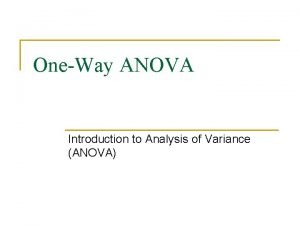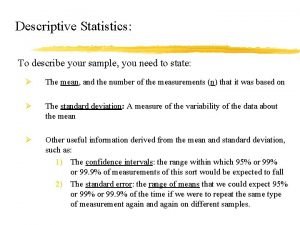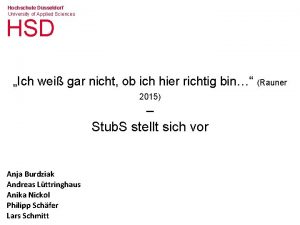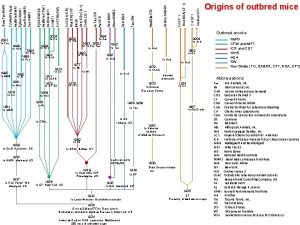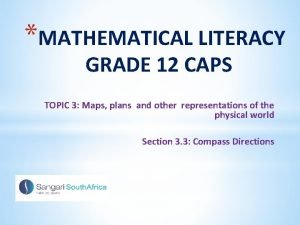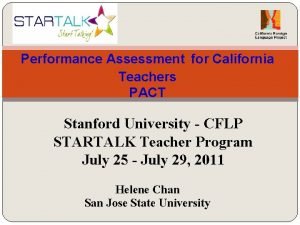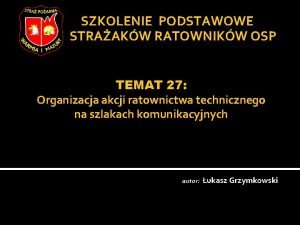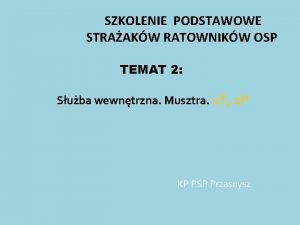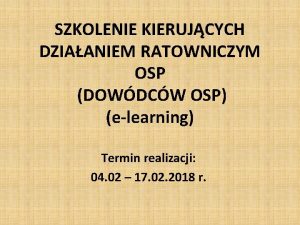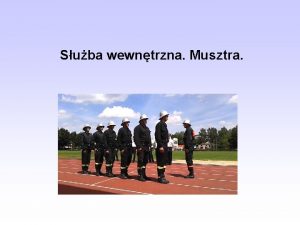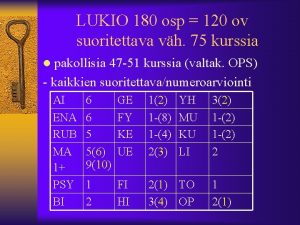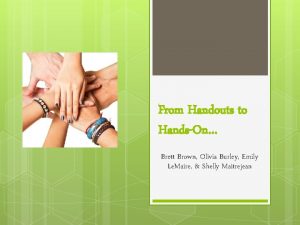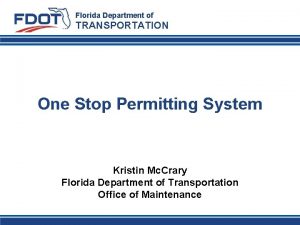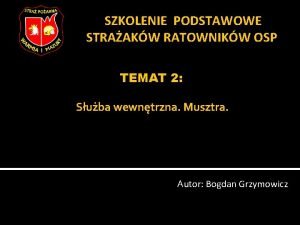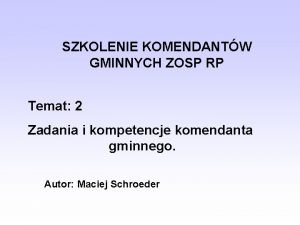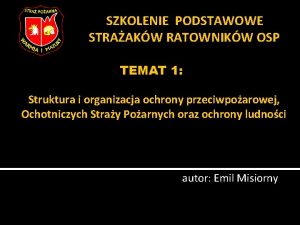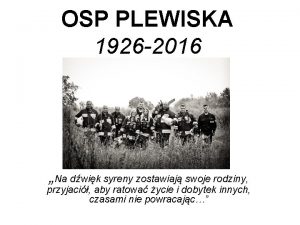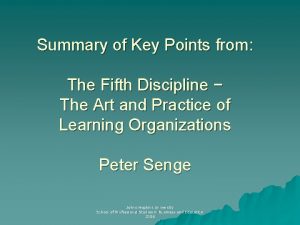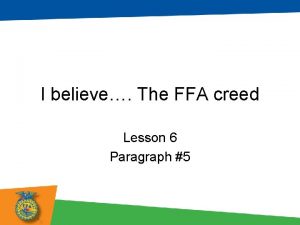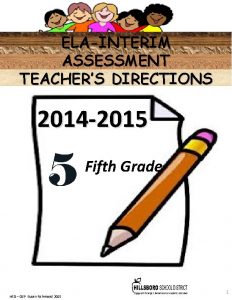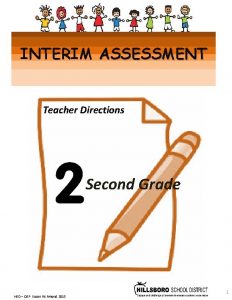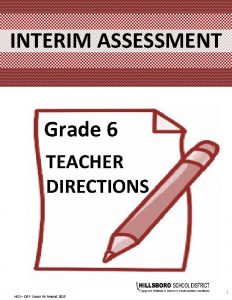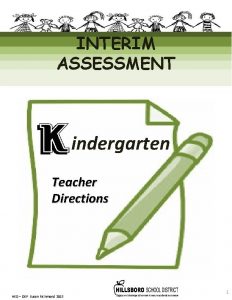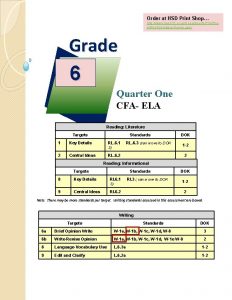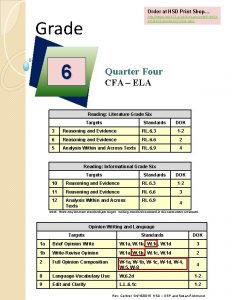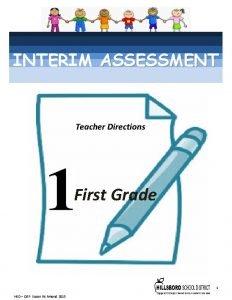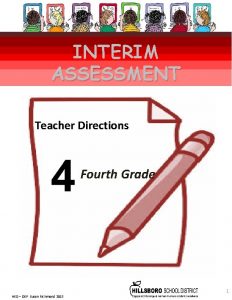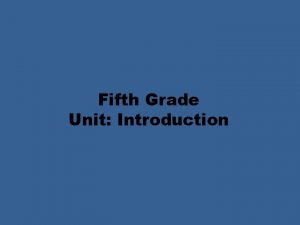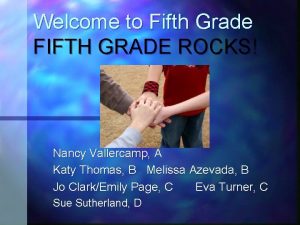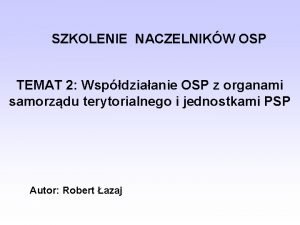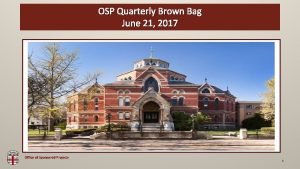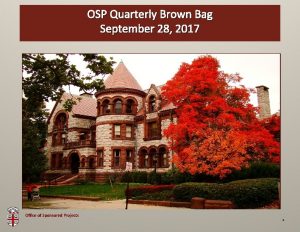ELAINTERIM ASSESSMENT TEACHERS DIRECTIONS Fifth Grade HSD OSP




































- Slides: 36

ELA-INTERIM ASSESSMENT TEACHER’S DIRECTIONS Fifth Grade HSD – OSP Susan Richmond 2015 1

All elementary ELA assessments were written, reviewed and revised by the following amazing and dedicated HSD K-6 th grade teachers. Reviewed and revised in June of 2015 by the following HSD K-6 th grade teachers. Written by the following HSD K-6 th grade teachers in 2014. Deborah Alvarado Lincoln Street Ko Kagawa Minter Bridge Deborah Alvarado Linda Benson West Union Jamie Lentz Mooberry Carrie Ellis Anne Berg Eastwood Sandra Maines Quatama Aliceson Brandt Eastwood Gina Mc. Lain TOSA Raquel Lemus Sharon Carlson Minter Bridge Teresa Portinga Patterson Alfonso Lule Deborah Deplanche Patterson Judy Ramer Consultant Sandra Maines Alicia Glasscock Imlay Sara Retzlaff Mc. Kinney Sonja Grabel Patterson Jami Rider Free Orchard Megan Harding Orenco Kelly Rooke Free Orchards Renae Iversen Teacher Mentor Angela Walsh Witch Hazel Ginger Jay Witch Hazel Tammy Cole Dori George Heather Girad Jamie Goldstein Jamie Lentz Berta Lule Heather Mc. Cullum Gina Mc. Lain Teresa Portinga Judy Ramer Irma Ramirez Sara Retzlaff Jean Summers Nikki Thoen Maritza Dash Jill Russo Performance Task Classroom Activities for K – 6 were written by Jamie Lentz, Gina Mc. Lain, Hayley Heider, Anna Wooley, Gretchen Erlandsen, Deborah Deplanche, Connie Briceno, Judy Ramer, Carrie Ellis, Sandra Maines, Renae Iversen, Anne Berg, Aliceson Brandt and Ko Kagawa. All assessments have been edited by Vicki Daniels. HSD – OSP Susan Richmond 2015 2

Important Note: The informational text “The Fight to Vote” has a grade equivalency of 6. 8. while the lexile is 850. Common Core Band Flesch-Kincaid® The Lexile Framework® 2 nd - 3 rd 1. 98 - 5. 34 420 - 820 4 th - 5 rd 4. 51 - 7. 73 740 - 1010 6 th – 8 th 6. 51 - 10. 34 925 - 1185 9 th – 10 th 8. 32 - 12. 12 10. 50 - 1335 11 th - CCR 10. 34 - 14. 20 11. 85 - 1385 The grade equivalent is in the high middle band range for 4 th – 5 th grade text and at the lower middle band lexile level. However, the general vocabulary of the text is simple and straightforward. The purpose of the text is clear and the structure is predictable. These qualitative measures explain why the text was posted for 5 th grade. It is the content specific vocabulary with multiple syllables, that brings this text up to a grade equivalent of 6. 8 (suffragists, Declaration of Independence, Amendment, Constitution, senator, etc. . ). Without these words the text measures closer to a grade five equivalent. Students can understand the meaning of these words within context although they may not be able to pronounce them. HSD – OSP Susan Richmond 2015 3

The HSD Elementary Interim Assessment is required. Please enter the student scores into Synergy. This assessment contains 20 total questions including 18 Selected Responses and 2 Constructed Responses. Selected Responses are 1 point each and Constructed Responses are 2 points each. Assessment Targets DOK-2 Key Ideas – Details DOK-2 Central Idea Standard 1 DOK 3 -4 Reasoning Standard 2 Standards 3, 6 • 2 Literature SRs • 2 Informational SRs • • Total: 4 Total: 6 Possible Points: 4 DOK 2 -3 Text Structures Possible Points: 4 Standards 5, 7 2 Literature SRs 2 Informational SRs 1 Literature CR 1 Informational CR • 3 Literature SRs • 3 Informational SRs Total: 6 Possible Points: 8 Possible Points: 6 Grade 5 Literature Standard DOK Level Informational Standard DOK Level St. 1 St. 2 St. 3 St. 5 St. 6 St. 7 2 2 3 3 4 3 St. 1 St. 2 St. 3 St. 5 St. 6 St. 7 2 2 3 4 4 2 Directions: • • Students read the passages Students answer the SR and CR Questions. *If you are not doing the performance task have students answer questions #1 -20 only. If you are not doing the performance task your students will stop on the red “stop sign. ” Grades K – 2 Students in kindergarten should have the passages read to them as a listening comprehension assessment. Students in grades 1 – 2 should read the passages independently if they can; however, students not reading at grade level may have the passages read to them. Grades 3 – 6 Students in grades 3 – 6 should read the passages independently unless an IEP signifies otherwise. HSD – OSP Susan Richmond 2015 4

Optional Performance Task Directions *If you are not doing the performance task have students answer questions #1 -20 only. Important Note: This assessment has an Optional Performance Task (it will not be recorded to Synergy). The purpose of the Performance Task (PT) is to allow those teachers to give a PT to students, if so desired, as an instructional experience for the SBAC assessment which will include a PT. Students should have access to spell-check resources but no grammar-check resources. Students can refer back to their passages, notes and 2 research constructed responses, as often they’d like if they are participating in the Performance Task. Directions for Performance Task Part 1 1. A Classroom Activity (30 Minutes) You may wish to have a 30 minute classroom activity. The purpose of a PT activity is to ensure that all students are familiar with the concepts of the topic and know and understand key terms (vocabulary) that are at the upper end of their grade level (words they would not normally know or are unfamiliar to their background or culture). The classroom activity DOES NOT pre-teach any of the content that will be assessed! 2. Read literary and informational passages (30 minutes) Remind students to take notes as they read. During an actual SBAC assessment students are allowed to keep their notes as a reference in order to complete their performance task. 3. Answer the selected and constructed response questions. Part 2 (after questions #1 -20) • A Full-Composition (70 Minutes) 15 minute break 70 Minutes 4. Students write their full composition (informational piece). SCORING An Informational Rubric is provided for the performance task. Students receive three scores: 1. Organization and Purpose 2. Evidence and Elaboration 3. Conventions HSD – OSP Susan Richmond 2015 5

Equal Rights for All (Rosa Parks/Women’s Suffrage) Performance Task Classroom Activity This classroom pre-activity follows the Smarter Balanced Assessment Consortium general design of contextual elements, resources, learning goals, key terms and purpose [http: //oaksportal. org/resources/] The classroom activity written by Renae Iversen. The Classroom Activity introduces students to the context of a performance task, so they are not disadvantaged in demonstrating the skills the task intends to assess. Contextual elements include: 1. an understanding of the setting or situation in which the task is placed 2. potentially unfamiliar concepts that are associated with the scenario 3. key terms or vocabulary students will need to understand in order to meaningfully engage with and complete the performance task The Classroom Activity is also intended to generate student interest in further exploration of the key idea(s). The Classroom Activity should be easy to implement with clear instructions. Please read through the entire Classroom Activity before beginning the activity with students to ensure any classroom preparation can be completed in advance. Throughout the activity, it is permissible to pause and ask students if they have any questions. Resources needed: 1. 2. 3. 4. Venn Diagram template (Ancillary materials) to share with the whole group Paragraphs for student groups (Ancillary materials) Vocabulary list for each student (Ancillary materials) Scratch paper for each group Learning Goals: 1. Students will understand the context of the key concepts related to the topic: equal rights and women’s suffrage through the Civil Rights Act and 19 th Amendment to the Constitution. Students will understand the key terms: Note: Definitions are provided here for the convenience of facilitators. Students are expected to understand these key terms in the context of the task, not memorize the definitions. 1. 2. 3. 4. Civil Rights-the rights that every person should have regardless of his or her sex, race, or religion Women’s Suffrage- the right of women to vote in an election segregation-the practice or policy of keeping people of different races, religions, etc. , separate from each other discrimination-the practice of unfairly treating a person or group of people differently from other people or groups of people 5. gender-the state of being male or female 6. ratify-to make official by signing it or voting for it [Purpose: The facilitator’s goal is to help students understand how the Civil Rights Act and the 19 th Amendment to the Constitution provided equal rights for all people. *Facilitators can decide whether they want to display ancillary materials using an overhead projector or computer/Smartboard, or whether they want to produce them as a handout for students. HSD – OSP Susan Richmond 2015

Equal Rights for All (Rosa Parks/Women’s Suffrage) Performance Task Classroom Activity continued… Facilitator says: Today we will be learning about two pieces of legislation that significantly affected equal rights in the US. We will be working in teams to draw out key ideas from short paragraphs and then coming together to complete a Venn diagram comparing/contrasting the two. If there is time, we will finish by drafting a main idea as a whole group. Facilitator says: Before we begin reading, there are some important vocabulary words you will need to know. [Hand out vocabulary list and read aloud each word and its meaning. Give further examples as needed but do not expand further. ] Facilitator says: Now we will be getting into 6 groups (Note: You may want to select groups ahead of time). Choose a reader, recorder, and a reporter. Reader will read the paragraph while others follow-along. The recorder will be listening to the group discussion and writing down two key details. The reporter will be sharing the key details with the whole group. [Walk around and make sure groups are on-track with the assignment. Try to keep this part to about 15 minutes unless you’ve chosen to make it a longer activity. ] Possible student responses (unscripted): ● Civil Rights Act passed in 1964. ● It ended segregation. ● President Johnson signed it into law. ● Segregation was banned in all public places. ● It banned discrimination at work. ● The 19 th Amendment passed in 1920. ● It gave women the right to vote. ● Susan B. Anthony made groups to get voting rights for women. ● Before this law women could not vote or own property. Facilitator says: Ok, reporters get the notes from recorders and be prepared to share. [Get responses from each group and include them in the Venn diagram where they would fit. ] HSD – OSP Susan Richmond 2015

Equal Rights for All (Rosa Parks/Women’s Suffrage) Performance Task Classroom Activity continued… Student responses (unscripted): Civil Rights Act ● ● ended segregation signed into law by Lyndon B. Johnson ended discrimination by employers paved the way for 2 more laws 19 th Amendment Similarities ● ● made equal rights for all people laws made to end segregation and discrimination ● ● ● gave women the right to vote formed organizations to get rights for women married women could not own property Facilitator says(if time): Based on the responses you shared it seems like the Civil Rights Act and 19 th Amendment have a number of things in common. If we were going to write an essay about the things they had in common, what could we use as a main idea? [Write the following sentence starter on the overhead so all students can see: The Civil Rights Act and the 19 th Amendment are similar because… Facilitator says: Help me finish this sentence: The Civil Rights Act and the 19 th Amendment are similar because… [Solicit ideas from students and form them to finish the sentence. ] Student Responses (unscripted): The Civil Rights Act and the 19 th Amendment are similar because they both helped guarantee that all people will have equal rights regardless of color or gender. Facilitator says: “In your performance task, you will be learning more about how Rosa Parks and the Women’s Suffrage Movement helped guarantee equal rights for all people. The group work you did today should help prepare you for the research and writing you will be doing in the performance task. ” Note: Facilitator should collect student notes from this activity. HSD – OSP Susan Richmond 2015

Ancillary materials for: Equal Rights for All (Rosa Parks/Women’s Suffrage PT) Adapted From: http: //www. readworks. org/passages/civil-rights-act 1. The Civil Rights Act of 1964, ended segregation in public places and banned employment discrimination because of race, color, religion, gender or national origin. It is one of the biggest legislative (law) achievements of the civil rights movement. President John F. Kennedy proposed it but southern members of Congress strongly opposed it. It was finally signed into law by President Lyndon B. Johnson. In the following years, Congress expanded the act and also passed additional legislation (laws) to bring equality to African Americans, such as the Voting Rights Act of 1965. 2. Under the Civil Rights Act of 1964, segregation on the grounds of race, religion or national origin was banned in all public places including: courthouses, parks, restaurants, theaters, sports arenas and hotels. African. Americans and other minorities could not be denied service based on the color of their skin. The act also stopped race, religion, national origin and gender discrimination by employers and labor unions. It created an Equal Employment Opportunity Commission so workers could file lawsuits if they were discriminated against. The act stopped the use of federal money for any program that discriminated, authorized the Department of Education to help with school desegregation, gave a higher status to the Commission on Civil Rights, and banned people from not allowing voters to vote if they were qualified to. For civil rights leader Martin Luther King Jr. , it was nothing less than a “second emancipation (freedom). ” 3. The Civil Rights Act was later expanded to bring Americans with disabilities, the elderly, and women in college sports under its umbrella. It also cleared the way for two major follow-up laws: the Voting Rights Act of 1965 and the Fair Housing Act of 1968. The Voting Rights Act banned literacy tests in order to vote and other discriminatory voting practices. The Fair Housing Act banned discrimination in the sale, rental, and financing (getting a loan) of property. Though the struggle against racism would continue, legal segregation had ended. 4. Adapted From: http: //www. history. com/topics/womens-history/19 th-amendment 5. Ratified (made into law) on August 18, 1920, the 19 th Amendment to the U. S. Constitution gave American women the right to vote—a right known as women’s suffrage. At the time the U. S. was founded, female citizens did not have all of the same rights as men, including the right to vote. It was not until 1848 that the movement for women’s rights went to a national level with a convention in Seneca Falls, New York. That convention was organized by abolitionists (people who were working to end slavery) Elizabeth Cady Stanton (1815 -1902) and Lucretia Mott (1793 -1880). 6. After the convention, the demand for the right to vote became a main part of the women’s rights movement. Stanton and Mott, along with Susan B. Anthony (1820 -1906) and other activists, formed organizations that raised public awareness and tried to persuade the government to give voting rights to women. After a 70 year battle, these groups finally were victorious with the passage of the 19 th Amendment in 1920. HSD – OSP Susan Richmond 2015

Vocabulary list for Equal Rights for All (Rosa Parks/Women’s Suffrage PT) 1. civil rights- the rights that every person should have regardless of his or her sex, race, or religion 2. women’s suffrage- a woman’s right to vote in an election 3. segregation- the practice of keeping people of different races, religions, etc. , separate from each other 4. discrimination- the practice of unfairly treating a person or group of people differently from other people or groups of people 5. gender- the state of being male or female 6. ratify- to make official by signing it or voting for it HSD – OSP Susan Richmond 2015

Venn Diagram for Equal Rights for All (Rosa Parks/Women’s Suffrage PT) 19 th Amendment Civil Rights Act Similarities HSD – OSP Susan Richmond 2015

Part 2 Performance Task You will: 1. Plan your writing. You may use your notes and answers. You may use a graphic organizer. 2. Write – Revise and Edit your first draft (your teacher will give you paper). 3. Your assignment: Part 2 Your school newspaper is producing a section about civil rights. The students in your class have been asked to contribute. You will write an informational article comparing Rosa Parks to Susan B. Anthony and the suffragists. Your article will be read by students, teachers and parents. Using all sources, develop a main idea about what both Rosa Parks, Susan B. Anthony and the suffragists had in common and how it affected civil rights in America. Choose the most important information to support your main idea. Then, write an informational article about the main idea with details from the sources. Use your own words except when quoting directly from the sources. How your report will be scored: 1. Statement of Purpose/Focus—how well you clearly state and maintain your controlling idea or main idea 2. Organization – how well the ideas progress from the introduction to the conclusion using effective transitions and how well you stay on topic throughout 3. Elaboration of Evidence – how well you provide evidence from sources about your topic and elaborate with specific information 4. Language and Vocabulary – how well you effectively express ideas using precise language that is appropriate for your audience and purpose 5. Conventions – how well you follow the rules of usage, punctuation, capitalization, and spelling HSD – OSP Susan Richmond 2015 12

Grades 3 - 5: Generic 4 -Point Informational/Explanatory Writing Rubric Performance Task Score Statement of Purpose/Focus and Organization Statement of Purpose/Focus The response is fully sustained and consistently and purposefully focused: Organization Development: Language and Elaboration of Evidence The response has a clear and effective organizational structure creating unity and completeness: The response provides thorough and convincing support/evidence for the controlling idea or main idea • controlling idea or main that includes the effective idea of a topic is focused, • use of a variety of transitional use of sources, facts, and clearly stated, and strongly strategies logical progression details: maintained. of ideas from beginning to end. • use of evidence from Exemplary • controlling idea or main sources is smoothly idea of a topic is introduced • effective introduction and integrated comprehensive, and communicated clearly conclusion for audience and relevant. within the context. purpose. • effective use of a variety of elaborative techniques. The response is adequately The response has an evident The response provides sustained and generally organizational structure and a adequate support/evidence focused: sense of completeness, though for the controlling idea or there may be minor flaws and main idea that includes the • focus is clear and for the some ideas may be loosely use of sources, facts, and most part maintained, connected: details: though some loosely related material may be present. • adequate use of transitional • some evidence from sources strategies with some variety is integrated, though Proficient • some context for the adequate progression of ideas citations may be general or controlling idea or main from beginning to end. imprecise. idea of the topic is adequate. • adequate introduction and • adequate use of some conclusion elaborative techniques. 4 3 The response is somewhat sustained and may have a minor drift in focus: • may be clearly focused on The response has an inconsistent organizational structure, and flaws are evident: The response provides uneven, cursory support/evidence for the controlling idea or main idea that includes partial or uneven use of sources, facts, and details: the controlling or main idea, • inconsistent use of but is insufficiently transitional strategies with sustained. little variety uneven progression of ideas from • evidence from sources is Developing • controlling idea or main beginning to end. weakly integrated, and idea may be unclear and citations, if present, are somewhat unfocused. • conclusion and introduction, uneven. if present, are weak. • weak or uneven use of elaborative techniques The response may be related The response has little or no The response provides to the topic but may provide discernible organizational minimal support/evidence little or no focus: structure: for the controlling idea or main idea that includes little • may be very brief may have • few or no transitional or no use of sources, facts, a major drift focus. strategies are evident. and details: 2 1 Emerging • may be confusing or ambiguous. 0 • frequent extraneous ideas may intrude. • use of evidence from the Language and Vocabulary The response clearly and effectively expresses ideas, using precise language: Conventions The response demonstrates a strong command of conventions: • use of academic and • few, if any, errors are domain-specific present in usage and vocabulary is clearly sentence formation. appropriate for the audience and • effective and purpose. consistent use of punctuation, capitalization, and spelling. The response adequately expresses ideas, employing a mix of precise with more general language. Use of domainspecific vocabulary is generally appropriate for the audience and purpose. The response demonstrates an adequate command of conventions: • some errors in usage and sentence formation may be present, but no systematic pattern of errors is displayed. • adequate use of The response expresses ideas unevenly, using simplistic language: punctuation, capitalization, and spelling. The response demonstrates a partial command of conventions: • use of domain- • frequent errors in specific vocabulary that may at times be inappropriate for the audience and purpose. usage may obscure meaning. • inconsistent use of punctuation, capitalization, and spelling. The response expression of ideas is vague, lacks clarity, or is confusing: The response demonstrates a lack of command of conventions: • uses limited • errors are frequent language or domainspecific vocabulary. and severe. source material is minimal, • meaning is often absent, in error, or • may have little sense obscure. irrelevant. of audience and purpose. A response gets no credit if it provides no evidence of the ability to [fill in with key language from the intended target]. HSD – OSP Susan Richmond 2015 13

Interim Research Constructed Response Answer Key Constructed Response Research Rubrics Target 4 ability to cite evidence to support opinions and/or ideas Question #10 Prompt: What evidence supports Rosa Parks’ opinion of segregation? Teacher /Rubric “Language Response” The response gives sufficient evidence of the ability to cite evidence to support the student’s response. Evidence could include the following details. Rosa parks hated segregation. She refused to drink from water fountains designated for “colored people. ” Bus driver says, “If you don’t stand up, I’m going to have you arrested. ” Parks responds, “You may do that. ” Parks says, “Why do you all push us around? ” Rosa decides to go to the Supreme Court. They decide to boycott the buses. They ride in taxis owned by African Americans. She appealed the court decision. The Supreme Court ruled that segregated buses violated the Constitution. Student “Language” Response Example The student uses sufficient evidence to support Rosa Park’s opinion of segregation. 2 Rosa Parks didn’t like segregation. In the text, “A Lesson in Courage”, it states, “She refused to drink from water fountains designated for ‘colored people’. ” Then, in the section, “Downtown Montgomery, Alabama”, she says, “Why do you all push us around? ” After she gets out of jail she decides to take it all the way to the Supreme Court. She says, “I will never ride a segregated bus again. ” They decide to boycott the buses. Instead they decide to ride in taxis owned by African Americans. Rosa Parks appeals to the Supreme Court and wins. The student uses partial evidence to support Rosa Park’s opinion of segregation. 1 0 Rosa Parks hated it. She hid from school buses when they came by. She refused to drink from water fountains. In the text she says, “I will never, ever ride a segregated bus again. ” She wins the Supreme Court case and gets to sit at the front of the bus. The student does not give relevant evidence to support Rosa Park’s opinion of segregation. I think it’s wrong to make people sit in different places on the bus. I like to pick where I sit. She won her court case and sat where she wanted. Standard RL. 5. 6 Describe how a narrator's or speaker's point of view influences how events are described. HSD – OSP Susan Richmond 2015 14

Interim Research Constructed Response Answer Key Constructed Response Research Rubrics Target 2 Locate, Select, Interpret and Integrate Information. Question # 20 Prompt: What new or different information from Part 2 could be added to Part 1 that would contribute more to understanding the events in “The Fight to Vote”? Use specific examples and details from both parts in your answer. Teacher /Rubric “Language Response” The response gives sufficient evidence of the ability to locate and select information from Part 2 that extends or explains specific details from Part 1. The response gives sufficient evidence of the ability to interpret and integrate information between Part 1 and Part 2 further explains information presented in Part 1 that could include: (1) a Declaration of Sentiments was signed by those wanting suffrage, (2) descriptions of the NWSA and AWSA , (3) when the two organizations merged, (4) others were also arrested along with Susan B Anthony in 1872, (5) women suffragists that picketed were arrested in 1917 outside of the White House, (6) by 1917 half the states have full or partial voting rights for women, (5) the name of the new amendment is called the Susan B. Anthony amendment (1919), and (7) in 1920 the amendment was passed or ratified into law. Student “Language” Response Example Student locates and integrates sufficient information from Part 2 that contributes more to Part 1 using specific examples and details from both parts. 2 Part 2 explains more about some of the events in Part 1, the “Fight to Vote”. In Part 1, suffragists met in 1848 to add the word women to the Declaration of Independence. Part 2 explains that this is addition is called the Declaration of Sentiments. In 1869 two organizations were formed to help women organize their fight to vote. These were not mentioned in Part 1 but helps explain how the women organized in order to perform many of they things they did in Part 2 (such as rallies and picketing). In Part 1, Susan B Anthony was stated as being arrested in 1872. In Part 2, it further explains that she was not alone, many others were also arrested. This helps to understand that it was a part of the bigger organization. I feel another important event that is not fully clarified in Part 1 is that the new amendment to the constitution allowing women to vote (clarified in Part 2), is actually called the Susan B. Anthony Amendment. Student locates and integrates partial information from Part 2 that contributes some to Part 1 using few examples or details from both parts. 1 0 Part 2 is like a timeline. It helps readers know more about what happened when the women suffragists wanted to fight for the right to vote. Part 1 is like a story I think. Anyway, in Part 2 you learn that a whole lot of women were arrested outside of the white House in 1917. You don’t learn that in Part 1. They were arrested for picketing. Student does not locate or integrate information from Part 2 that contributes more to Part 1. Everyone should be able to vote. Women and men. That is why the women were fighting, so everyone could vote. I really liked it when they were able to vote for the first time. Standard RI. 5. 6 Analyze multiple accounts of the same event or topic, noting important similarities and differences in the point of view they represent. HSD – OSP Susan Richmond 2015 15

2014 -2015 Interim Assessment Selected Response Answer Key Question 1 What did the bus driver ask Rosa Parks to do on the bus? RL. 1 A Question 2 What is the main idea of the section “The Courthouse”? RL. 1 D Question 3 What details best summarize the introduction? RL. 2 B Question 4 What information best supports the fact that the protesters disagreed with segregated buses in the section, A Bus Stop on Monday Morning? Pick the two choices that are correct. RL. 2 (BOTH MUST BE CORRECT) Question 5 What did E. D. Nixon and Rosa agree to do? RL. 3 Question 6 Which two answers best explain why African Americans chose the method they used to end segregation on the bus? RL. 5 (BOTH MUST BE CORRECT) Question 7 What conclusion can you draw from author’s use of the phrase, “booing the decision” in the section The Courthouse? RL. 6 Question 8 What detail in the visual supports the tone of how Rosa Parks is feeling in “A Lesson in B, D D Courage”. RL. 7 B Question 9 How is Rosa Park’s courage best illustrated in the drama “A Lesson in Courage? RL. 7 C Question 10 RL. 6 Constructed Response RL. 5. 6 Question 11 Why did the women suffragists want a change in the Declaration of Independence? RI. 1 Question 12 How much time was there between the introduction of a woman’s right to vote amendment and when women actually were allowed to vote? RI. 1 Question 13 Which of the following statements best describes the author’s main purpose in “The Fight to Vote”? RI. 2 2 pts. B C B Question 14 What question is not answered by details in this passage? RI. 2 C Question 15 What is the connection between Seneca Falls and November 2 nd, 1920? RI. 3 A Question 16 What text structure is in both Part 1 and 2 of “The Fight to Vote”? RI. 5 D Question 17 What might be the reason “The Fight to Vote” was divided into two sections? RI. 6 C Question 18 What two events happened before the NWSA and AWSA merged? RI. 7 A Question 19 When did Susan B Anthony first vote in a presidential election? RI. 7 D Question 20 RI. 6 Constructed Response RI. 5. 6 HSD – OSP Susan Richmond 2015 2 pts. 16

Grade 5 Interim Name___________ HSD – OSP Susan Richmond 2015 17

A Lesson in Courage: More than Fifty Years Ago, Rosa Parks Changed the Country Forever Grade Equivalency 5. 0 Lexile Measure 550 L Mean Sentence Length 7. 57 Mean Log Word Frequency 3. 32 Word Count 719 Cast of Characters • Narrators 1, 2, 3 • Bus driver • Rosa Parks • Bus riders 1, 2 • Police officers 1, 2 • E. D. Nixon, civil rights leader • Raymond Parks, Rosa Parks' husband • Protesters 1, 2, 3 • Fred Gray, Rosa Parks' lawyer Growing up, Rosa Parks knew what to do when she saw a school bus—hide. The bus wasn’t coming to take her to school. It was only for white children, and when the kids saw Rosa walking, they would pelt her with trash. In the 1920 s, the South was segregated. African Americans didn’t have the same rights as white people. They were forced to sit in the back of public buses and could not go to the same schools as white people. Rosa Parks hated segregation. She refused to drink from water fountains designated for "colored" people. (At that time, some people referred to black people as "colored. ") She joined the National Association for the Advancement of Colored People (NAACP) to fight for equal rights. Scene 1: Downtown Montgomery, Alabama Narrator 1: Rosa Parks boards a bus on her way home from work. Narrator 2: She sits in the front row of the "colored" section. Bus driver: Next stop, Empire Theater! Narrator 3: After the bus grinds to a stop, a few white people get on. One white man is left without a seat. Bus driver: (to Parks and the people in her row) Let me have those seats. Narrator 1: Parks and the people in her aisle don’t move. Bus driver: (threatening) You know white folks and colored people can’t sit in the same row. Let me have those seats. Narrator 2: The others get up and move to the back, but Parks stays put. Rosa Parks: (to herself) The more we give in to segregation, the worse it gets. Bus driver: (to Parks) If you don’t stand up, I’m going to have you arrested. Parks: (quietly) You may do that. Bus rider 1: (in a hushed tone) I wonder what’s going to happen. Bus rider 2: (worriedly) I don’t know, but she’s in trouble now. Narrator 3: A few minutes later, two police officers arrive. Police officer 1: Why didn’t you stand up when the driver spoke to you? Parks: (defiantly) Why do you all push us around? Police officer 2: I don’t know, but the law is the law, and you’re under arrest. HSD – OSP Susan Richmond 2015 18

A Lesson In Courage continued Scene 2: Park’s house Narrator 1: After Parks is released from jail on bail, she talks with the local NAACP president, E. D. Nixon; her husband, Raymond Parks; and a few others. Parks: I know one thing: I will never, ever ride a segregated bus again. E. D. Nixon: Rosa, how would you feel about making your arrest a test case against segregation? Raymond Parks: We could take this all the way to the Supreme Court. Parks: (after a moment) I’ll do it. Nixon: Good. Now let’s show white people how much they need us. Black people ride city buses more than anyone else. If we don’t ride, the bus company could go bankrupt. Tell everyone—we’re going to boycott the buses. Scene 3: A Bus Stop on Monday Morning Narrator 2: Dark clouds loom overhead. African Americans huddle at bus stops, but they’re waiting for taxis owned by African Americans—not for buses. Protester 1: I’m glad we’re finally teaching the bus company a lesson. Protester 2: Me too. I’m tired of standing on buses when there are empty seats in the white section. Protester 3: I’d rather walk to work every day than put up with segregation any longer Scene 4: The Courthouse Narrator 3: The courtroom is packed. Parks’ lawyer speaks on her behalf. Fred Gray: The defendant pleads not guilty. Narrator 1: The bus driver takes the stand. Bus driver: I asked her to move. She refused. Judge: I find Rosa Parks guilty. She must pay a $10 fine, plus $4 in court costs. Narrator 2: Parks’ supporters react angrily, booing the decision. Parks: You haven’t heard the last from us. The crowd might have booed, but the guilty verdict was exactly what Parks wanted. She immediately appealed the decision. When the state court ruled in her favor, the city took the case to the U. S. Supreme Court. In the meantime, the bus boycott continued. On Nov. 13, 1956, the African American community’s efforts paid off. The Supreme Court ruled that Alabama’s segregated buses violated the Constitution. A month later, Rosa Parks boarded a bus for the first time in more than a year. This time, she sat in the front seat. HSD – OSP Susan Richmond 2015 19

1. What did the bus driver tell Rosa Parks to do on the bus? A. “Let me have those seats. ” B. “If you don’t stand up, I’m going to have you arrested. ” C. “Why didn’t you stand up when the driver spoke to you? ” D. “The law is the law, and you’re under arrest. ” Standard RL. 5. 1 Quote accurately from a text when explaining what the text says explicitly and when drawing inferences from the text. 2. What is the main idea of the section “The Courthouse”? A. She pleads not guilty. B. The judge finds her guilty. C. She sat in the front seat. D. Segregated buses violated the constitution. HSD – OSP Susan Richmond 2015 20

3. Which detail best summarizes the introduction? A. The bus took Rosa to school. B. African Americans didn’t have the same rights as white people. C. African Americans were forced to sit in the back of the bus. D. Rosa joined a national association to fight for equal rights. Standard RL. 5. 2 Determine a theme of a story, drama, or poem from details in the text, including how characters in a story or drama respond to challenges or how the speaker in a poem reflects upon a topic; summarize the text. 4. What information best supports the fact that the protesters disagreed with segregated buses in the section, “A Bus Stop on Monday Morning”? Pick the two choices that are correct. A. African Americans huddled at bus stops. B. “I’m tired of standing on buses when there are empty seats in the white section. ” C. They waited for taxis owned by African Americans. D. “I’d rather walk to work every day than put up with segregation any longer. ” HSD – OSP Susan Richmond 2015 21

5. In Section 2, “Parks’ House, ” what action did Rosa and Nixon agree to take? A. They were tired of standing on buses when there were empty seats. B. Nixon and Parks believed African Americans rode city buses more than anybody else. C. Rosa decided to never ride a segregated bus again. D. They felt Rosa’s arrest should be made a test case against segregation. Standard RL. 5. 3 Compare and contrast two or more characters, settings, or events in a story or drama, drawing on specific details in the text (e. g. , how characters interact). 6. Which two answers best explain why African Americans chose the method they used to end segregation on the bus? A. Refusing to move on the bus showed a determination to end segregation. B. Fighting the guilty verdict all the way to the Supreme Court changed the law. C. Paying the fine showed respect for the law. D. Boycotting the buses could bankrupt the bus company. Standard RL. 5. 5 Explain how a series of chapters, scenes, or stanzas fits together to provide the overall structure of a particular story, drama, or poem HSD – OSP Susan Richmond 2015 22

7. What conclusion can you draw from the author’s use of the phrase, “booing the decision” in the section The Courthouse? A. The supporters were happy with the decision. B. Segregation is helpful for seating people on the bus according to the author. C. Rosa Parks was happy to get the guilty verdict. D. The author doesn’t like segregation. Standard RL. 5. 6 Describe how a narrator's or speaker's point of view influences how events are described. 8. Which of the stage directions contribute to the tone of how Rosa Parks is feeling in “A Lesson in Courage”? A. Rosa Parks hated segregation. She refused to drink from water fountains designated for “colored” people. B. Bus Driver: (to Parks) “If you don’t stand up, I’m going to to have you arrested. ” Parks: (quietly) “You may do that. ” C. Bus rider 1: (in a hushed tone) “I wonder what’s going to happen? ” D. Raymond Parks: “We could take this all the way to the Supreme Court. ” Parks: (after a moment) “I’ll do it. ” Standard RL. 5. 7 Analyze how visual and multimedia elements contribute to the meaning, tone, or beauty of a text (e. g. , graphic novel, multimedia presentation of fiction, folktale, myth, poem). HSD – OSP Susan Richmond 2015 23

9. How is Rosa Park’s courage best illustrated in the drama “A Lesson in Courage”? A. Rosa Parks does not like segregation. B. Rosa is tired of sitting in the back of the bus. C. Rosa told the bus driver he may have to arrest her. D. Rosa teaches the bus company a lesson. Standard RL. 5. 7 Analyze how visual and multimedia elements contribute to the meaning, tone, or beauty of a text (e. g. , graphic novel, multimedia presentation of fiction, folktale, myth, poem). 10 What evidence from the text supports Rosa Parks’ opinion of segregation? Constructed Response Research Rubrics Target 4 ability to cite evidence to support opinions and/or ideas HSD – OSP Susan Richmond 2015 Standard RL. 5. 6 Describe how a narrator's or speaker's point of view influences how events are described. 24

The Fight to Vote Women suffragists changed the United State March 01, 2013 By Nellie Gonzalez Cutler Time for Kids Grade Equivalent 6. 8 Lexile Measure 850 L Mean Sentence Length 13. 26 Mean Log Word Frequency 3. 61 Word Count 252 Part 1 Women suffragists marched in the streets across the nation. "We hold these truths to be selfevident: that all men are created equal. " With those words, the Declaration of Independence set forth the idea. But the women at the Woman's Rights Meeting in New York, in 1848, felt that a key phrase was missing. Elizabeth Cady Stanton, Lucretia Mott and others rewrote it to say, "All men and women are created equal. ” They said that it was "the duty of the women of this country" to fight for suffrage, or the right to vote. New York was the start of a long road to suffrage. Those who wanted to have voting rights for all Americans were called suffragists. They gave talks and traveled the country. In 1872, Susan B. Anthony voted in New York. She was arrested for breaking the law. "My rights, my civil rights, my political rights, my legal rights, are all alike ignored, " she said at her trial. Six years later a senator of California, announced an amendment to the Constitution to ensure that women could vote. But it took another 42 years before all women in the U. S. were given the right to vote. On November 2, 1920, 8 million women voted for president for the first time. The women who blazed the trail did not live to see that day. In her last speech, one month before she died, in 1906, Anthony urged women to keep fighting for the vote. "Failure, " she told them, "is impossible. “ Declaration of Independence: A July 4 th, 1776 statement declaring the original 13 colonies as no longer part of the British Empire. suffrage: The right to vote civil rights: Laws protecting American freedoms locally without discrimination. political rights: Laws protecting American freedoms rights to justice without discrimination. judicial rights: Rights of the U. S. court system. amendment: A change made to a law. HSD – OSP Susan Richmond 2015 25

The Fight to Vote (continued) Part 2 One Step at a Time Women worked hard to get to vote. Here are some of the main events. 1848 The Woman's Rights Convention is held in Seneca Falls, New York. Elizabeth Cady Stanton writes the Declaration of Sentiments 1. 1869 Stanton and Susan B. Anthony form the National Woman Suffrage Association (NWSA). Only women can join. 1869 Lucy Stone forms the American Woman Suffrage Association (AWSA). It is open to men and women. 1872 Anthony and supporters vote in the presidential election. They are arrested. 1878 A woman’s suffrage amendment is first introduced in the U. S. Congress. 1890 The NWSA and AWSA merge to form the National American Woman Suffrage Association. 1912 -14 Women hold rallies in New York City and Washington, D. C. 1917 Police arrest women who are picketing outside the White House. By 1918, about half the states have granted full or partial voting rights to women. 1919 Congress passes the 19 th Amendment, called the Susan B. Anthony Amendment. It is ratified, or confirmed, one year later. 1 Declaration of Sentiments: is a document signed in 1848 by 68 women and 32 men— 100 out of some 300 attendees at the first women's rights convention to be organized by women claiming all women should have the right to vote. HSD – OSP Susan Richmond 2015 26

11. Why did the women suffragists want a change in the Declaration of Independence? A. They wanted it to say all men and women are created equal. B. They felt like a key phrase was missing. C. They felt it was the duty of the women to fight for their rights. D. It was the Woman’s Rights Convention in New York. Standard RI. 5. 1 Quote accurately from a text when explaining what the text says explicitly and when drawing inferences from the text. 12. How much time was there between the introduction of a woman’s right to vote amendment and when women actually were allowed to vote? A. 12 years B. 6 years C. 42 years D. 14 years HSD – OSP Susan Richmond 2015 27

13. Which of the following statements best describes the author’s main purpose in “The Fight to Vote”? A. The author wrote this article to convince women that it is important to vote. B. The author describes how woman suffragists fought for women to be able to vote in the United States. C. The author told about the life of an important suffragist, Susan B. Anthony. D. The author describes the challenges faced by women in the late 1800 s and early 1900 s. Standard RI. 5. 2 Determine two or more main ideas of a text and explain how they are supported by key details; summarize the text 14. Which question is not answered by details in this passage? A. What rights did Susan B. Anthony feel were being violated? B. How many women voted in the 1920 presidential election? C. Why did the NWSA only allow women to join? D. What did suffragists do? HSD – OSP Susan Richmond 2015 28

15. What is the connection between Seneca Falls and November 2 nd, 1920? A. It was the beginning of the fight for women to vote, which became legal in 1920. B. Seneca Falls was in New York where the women suffragists met. C. Eventually, an amendment to the constitution was introduced. D. In 1920, women voted in a presidential election for the first time. Standard RI. 5. 3 Explain the relationships or interactions between two or more individuals, events, ideas, or concepts in a historical, scientific, or technical text based on specific information in the text 16. What answer describes the text structure of both Parts 1 and 2 of the “The Fight to Vote”? A. compare and contrast B. problem and solution C. cause and effect D. chronology Standard RI. 5. 5 Compare and contrast the overall structure (e. g. , chronology, comparison, cause/effect, problem/solution) of events, ideas, concepts, or information in two or more texts. HSD – OSP Susan Richmond 2015 29

17. What might be the reason “The Fight to Vote” was divided into two sections? A. Both sections are about women’s rights to vote. B. The first section tells about the struggles women went through to have the right to vote. C. The first section gives specific details about the events, while the second section summarizes the events in a timeline. D. The second section outlines the events that led up to women having the right to vote. Standard RI. 5. 6 Analyze multiple accounts of the same event or topic, noting important similarities and differences in the point of view they represent. 18. Which two events happened before the NWSA and AWSA merged? A. Women suffragists were arrested and the amendment was first introduced in the U. S. Congress B. A Woman’s Rights Convention was held in Seneca Falls and partial voting rights were granted to women. C. The NWSA and AWSA merged and women held rallies. D. Women voted in a presidential election for the first time and congress passed the 19 th amendment. Standard RI. 5. 7 Draw on information from multiple print or digital sources, demonstrating the ability to locate an answer to a question quickly or to solve a problem efficiently HSD – OSP Susan Richmond 2015 30

19. When did Susan B. Anthony first vote in a presidential election? A. 1920 B. 1878 C. 1848 D. 1872 Standard RI. 5. 7 Draw on information from multiple print or digital sources, demonstrating the ability to locate an answer to a question quickly or to solve a problem efficiently 20. What new or different information from Part 2 could be added to Part 1 that would contribute to better understanding the events in The Fight to Vote? Use specific examples and details from both parts in your answer. Constructed Response Research Rubrics Target 2 Locate, Select, Interpret and Integrate Information. HSD – OSP Susan Richmond 2015 Standard RI. 5. 6 Analyze multiple accounts of the same event or topic, noting important similarities and differences in the point of view they represent. 31

STOP Close your books and wait for instructions! HSD – OSP Susan Richmond 2015 32

Part 2 Performance Task You will: 1. Plan your writing. You may use your notes and answers. You may use a graphic organizer. 2. Write – Revise and Edit your first draft (your teacher will give you paper). 3. Your assignment: Part 2 Your school newspaper is producing a section about civil rights. The students in your class have been asked to contribute. You will write an informational article comparing Rosa Parks to Susan B. Anthony and the suffragists. Your article will be read by students, teachers and parents. Using all sources, develop a main idea about what both Rosa Parks, Susan B. Anthony and the suffragists had in common and how it effected civil rights in America. Choose the most important information to support your main idea. Then, write an informational article about the main idea with details from the sources. Use your own words except when quoting directly from the sources. How your report will be scored: 1. Statement of Purpose/Focus—how well you clearly state and maintain your controlling idea or main idea 2. Organization – how well the ideas progress from the introduction to the conclusion using effective transitions and how well you stay on topic throughout 3. Elaboration of Evidence – how well you provide evidence from sources about your topic and elaborate with specific information 4. Language and Vocabulary – how well you effectively express ideas using precise language that is appropriate for your audience and purpose 5. Conventions – how well you follow the rules of usage, punctuation, capitalization, and spelling HSD – OSP Susan Richmond 2015 33

HSD – OSP Susan Richmond 2015 34

HSD – OSP Susan Richmond 2015 35

HSD – OSP Susan Richmond 2015 36
 F critical value table
F critical value table Tukey hsd formula
Tukey hsd formula Stubs hsd
Stubs hsd Hsd-nsa-cf-1-
Hsd-nsa-cf-1- Kim kroll teachers pay teachers
Kim kroll teachers pay teachers Mathematical literacy grade 12 maps and scales
Mathematical literacy grade 12 maps and scales Performance assessment for california teachers
Performance assessment for california teachers Kurs podstawowy osp prezentacje
Kurs podstawowy osp prezentacje Dystynkcje osp na mundur galowy
Dystynkcje osp na mundur galowy Platforma wint
Platforma wint Dystynkcje osp na mundurze
Dystynkcje osp na mundurze Raporty osp
Raporty osp Fdot psee
Fdot psee Color 051909
Color 051909 Osp it-beratung
Osp it-beratung Osp entek
Osp entek Osp120
Osp120 Olivia burley
Olivia burley Fdot osp
Fdot osp Regulamin musztry wojskowej
Regulamin musztry wojskowej Odznaczenia osp
Odznaczenia osp Osp niwki
Osp niwki Osp janowice
Osp janowice Az osp fe
Az osp fe Osp emory
Osp emory Naczelnik osp wymagania
Naczelnik osp wymagania Brwinw
Brwinw Obowiązki komendanta gminnego osp
Obowiązki komendanta gminnego osp Osp gmu
Osp gmu Struktura osp
Struktura osp Harvard osp
Harvard osp Ošp
Ošp Osp plewiska
Osp plewiska Senge fifth discipline summary
Senge fifth discipline summary First korotkoff sound
First korotkoff sound Fifth gear loop the loop
Fifth gear loop the loop 5th paragraph of the ffa creed
5th paragraph of the ffa creed
